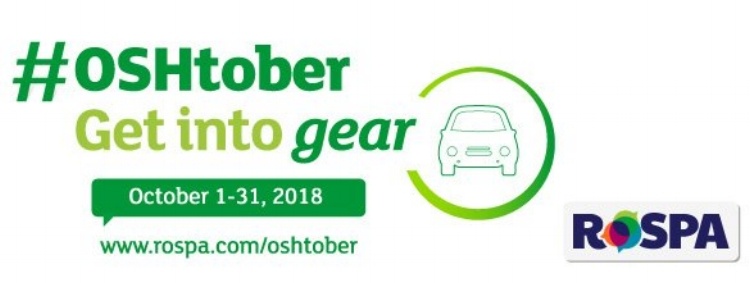#OSHtober is back and this year it's all about driving for work. From delivery services to sales people, almost every organization uses the road while on the clock at some point.
It's commonly believed that as long as a worker has a valid driver's license and that they comply with traffic laws, they can do as much driving for work as they need or want to. In reality, driving for work is a team effort between workers and their organizations.
This October, RoSPA wants to ensure that everyone who drives for work knows their responsibilities, and those of their employer, when they are on the road. Keep in mind that driving for work isn't limited to workers whose job titles are "Driver" and whose jobs consist primarily of driving. It includes all types of vehicles or jobs that require getting from one place or another during working hours. For example:
- Delivery trucks / couriers
- Taxis /driving services
- Buses
- Emergency service vehicles
- Company cars / personal vehicles
- Sales people
- Social workers
- Trades people
While commuting to and from work is not considered to be driving for work, the Health Safety Executive (HSE) still estimates that a quarter of all road accidents involve someone who was driving as part of their job, either in a company vehicle or with a personal vehicle (car allowance).
Here are a few basic concepts to help get your fleet on the right track:
- Choose safe vehicles. Cars are constantly evolving to include new safety features. When determining the criteria vehicles must meet in order to be part of your fleet, make sure you weigh the pros and cons of these features, and choose which you think would be most beneficial to your drivers. If you are using a personal vehicle, keep expectations realistic. Not everyone will have a vehicle equipped with the latest and greatest features, even if the vehicle is in good shape.
- Ensure vehicles are well maintained. Whether employees have access to a company fleet or use their own vehicles, it is important that employers inspect vehicles that will be used for work purposes on no less than an annual basis. Any identified issues should be dealt with before the next work related trip or as soon as possible. Drivers who cannot avoid travelling while their vehicle undergoes maintenance should be given access to a temporary vehicle.
- Have written policies and procedures in place for your workers. Anytime a worker is on the clock, regardless of whether or not they are in the office, they should be expected to follow the health and safety laws and procedures you have in place. These should outline the consequences of drugs and alcohol use, as well as detail what the company will or won't cover in the event of any tickets or accidents.
- Make sure all drivers are well educated. All of your drivers must have a valid license, and have good knowledge of the rules of the road. They should also be aware of your company's policies and expectations when it comes to being on the road.
- Keep the paperwork current. It is important that you ensure registration and insurance on all vehicles used for work are kept renewed on time and that all information is up to date. Some organizations may choose to help pay the fees for workers using their own vehicles for work purposes, while others may not. Ensure this is clear with your workers before they begin driving for work.
With these things in mind, let's help RoSPA keep workers safe on the roads this #OSHtober. Take a few minutes and review your driving policies with your workers, set up vehicle inspections, and ensure your fleet is winterized for the upcoming season. Not only will your workers be safer on the roads, so will everyone else.


Let Us Know What You Thought about this Post.
Put your Comment Below.